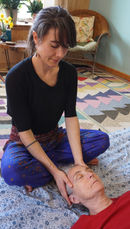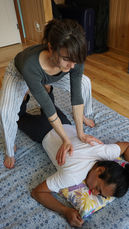Thai Massage
Thai massage is like yoga, acupressure, and massage all rolled into a relaxing and rejuvenating session.
Thai massage is an ancient form of bodywork that uses rhythmic compression, acupressure, and stretches to restore well-being and relax the body and mind.
The philosophy of Thai massage is based on the concept of "sen sip" or energy channels throughout the body. Traditionally, the sen lines are believed to correspond to various bodily energies and systems. Working the lines with compression, acupressure, and stretching is believed to stimulate and balance these energies and organ systems. The rhythmic pressure and movements are deeply relaxing and comforting.
Phoebe has trained in the Chiang Mai style of northern Thailand and is enthusiastic about introducing clients to this gentle but powerful modality of bodywork.
A special note about the photos on this page:
Some of these photos may look like dramatic stretches, but it’s important to remember that these represent each individual’s abilities.
These photos are meant to illustrate some of the possibilities of Thai massage, but techniques are always modified or omitted to account for individual differences and needs. Your Thai massage session may look very different from some of these photos to account for differences in physical abilities.


How is Thai massage different from typical Western style massage?
Thai massage is different from the types of massage many Americans are accustomed to in some key ways. During a Thai massage:
-
The client is fully clothed.
-
The session takes place on a soft mat on the floor instead of a massage table.
-
No lotions or oils are used because the focus will be on compressions, acupressure, and stretches instead of gliding strokes.
-
The massage therapist will use their hands, as well as feet, knees, and elbows to facilitate compressions and stretches.
-
The massage therapist may be in close bodily contact with the client during some of the stretches.
How is Thai massage similar to typical Western massage?
It's important to highlight the similarities Thai massage has with Western massage styles. For instance, the comfort and safety of the client is paramount during a Thai massage just like a Western massage.
Thai massage sessions are each modified to accommodate different body types, ages, abilities, and preferences. Be sure to talk about your preferences during the intake discussion before the session.


What are some of the benefits of Thai massage?
Thai massage sessions deeply relax the body and mind. It can help improve range of motion, muscle elasticity, circulation, and lymph flow.
The “sen line” acupressure work is traditionally believed to correspond to various bodily energies and systems. Working the sen lines with compression and acupressure is believed to stimulate and balance these energies.
Thai massage is also a great option of bodywork for people who are not comfortable undressing for a massage. Being clothed during a bodywork session can increase a sense of safety and comfort.
Who is Thai massage for?
A common misconception is that Thai massage is only for young, flexible people; this simply isn't true. Many older adults love, and even prefer, Thai massage because it doesn’t require them to undress and there’s an emphasis on joint mobility and whole body care.
Stretches are only done to the individual’s ability and comfort level, and all techniques can be modified or omitted to account for individual differences and needs.


What should I wear during a Thai massage?
Wear comfortable clothing that allows for movement - preferably something stretchy or loose - like tee shirts, sweatshirts, or activewear tops. Yoga pants, sweat pants, modest running shorts, flowy pants, or scrubs are all good options.


















